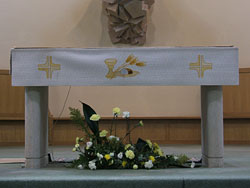 This is the first of a series of short articles on the sacraments. It is intended for Catholics who want to reflect more deeply on their faith and practice and for non-Catholics who are curious about the Catholic faith and want to know more.
This is the first of a series of short articles on the sacraments. It is intended for Catholics who want to reflect more deeply on their faith and practice and for non-Catholics who are curious about the Catholic faith and want to know more.
Before considering the individual sacraments in the life of the Church one needs first to develop some understanding of what the sacraments have in common, what the essence of a sacrament is. In the simplest terms, sacraments are effective signs of God’s love – they not only point to God’s grace they communicate it to us. But this simple statement hides the full richness of the Church’s teaching.
The word, “sacrament”, comes from the Latin, “sacramentum”, which simply means, “to make sacred”. The Latin term is a translation of the Greek, “mysterion”, used by Paul to refer to God’s plan of salvation which was fulfilled in Christ. (This is why we often refer to the sacraments as mysteries – the term used by the Eastern Churches.) For centuries after Christ the Western Church used the term “sacrament” to refer to this great “mystery” of God’s self- revelation in Christ. Gradually the Church came to associate this great mystery with specific actions by which God’s love and redemptive work is communicated to us. These are the seven sacraments of the Church.
What gives the sacraments their power and significance? The answer lies in what theologians have called the primordial sacrament (Cf Schillebeeckx, “Christ the Sacrament of the Encounter with God”) – that great sacrament in which all sacraments, and indeed, the life of the Church, has its origin. That sacrament is Christ himself. In the life, death and Resurrection of Christ we see, “our God made visible and are caught up in the love of the God we cannot see” (Preface of the First Mass for Christmas) .Unlike the Jewish or Islamic faiths, for whom God is hidden we, as Christians, see in Christ the, “image of the invisible God” (Paul, Epistle to the Colossians). But Christ not only shows us in his teaching, his healing, his suffering and death what God is like; He Himself is the vehicle for God’s loving grace. The Incarnation, by which God became man, is God’s chosen way of being present to us. And that incarnate presence, through the sacraments of the Church, continues to this day. It is through these sacraments that the love of God is mediated to his people. The sacraments are not just symbols – they convey the grace they signify.
But might God have done things differently? Are the Church and the sacraments exclusive means of grace? If so, what can we say of those who are not members of the Church? These are less difficult questions than they might seem. God, in his wisdom, has given the sacraments as a means of sharing his life principally because they are suited to our human nature. Water is essential for life – so water is used in Baptism, which is principally about new life in Christ. And bread and wine are staple parts of the diet with immense symbolic importance – as is a meal with friends. So God uses these material signs - which are already familiar to us in our everyday lives – for his own loving purpose.
But the fact that God has chosen to communicate his grace via sacraments does not mean that God Himself is bound by them. Just as his love and mercy is unbounded we are bound to believe that, through the power of the Holy Spirit, God is active throughout the world and so grace is communicated to unknown numbers of people, Christian and non-Christian. The key problem we face here is that without the visible signs of grace we too often fail to see God’s action in the world. However, it may be that if we could just open our eyes we might see more clearly. And it should be no surprise to us if we find that where grace abounds God has used material signs and symbols appropriate to our human nature to communicate his love.
Further reading:
“The Celebration of the Christian Mystery,” in the CATECHISM OF THE CATHOLIC CHURCH